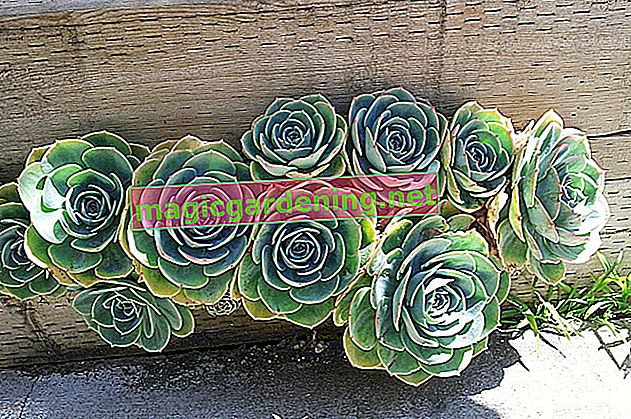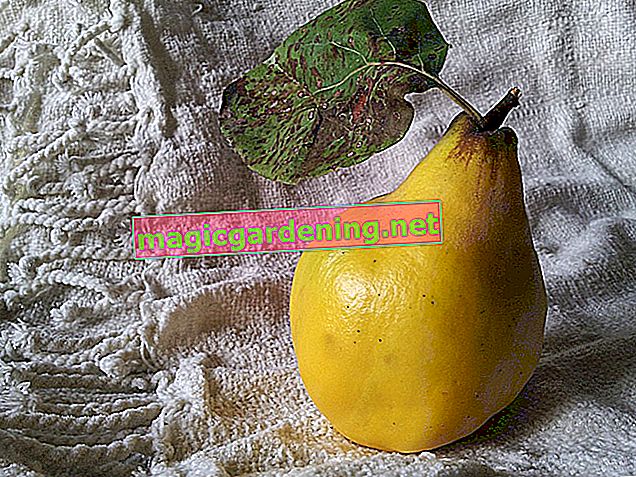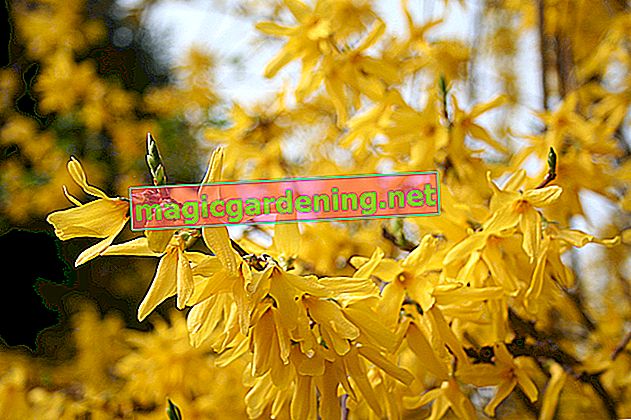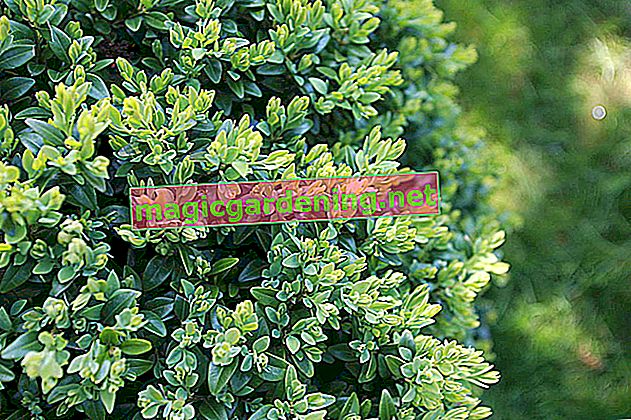
Fruit wood makes the difference
When it comes to pruning, black currants occupy a special position among currants. The juiciest berries thrive on annual long shoots . Among the diverse types of shoots, you can identify the valuable fruit wood with a length of more than 20 centimeters . Furthermore, a light brown color indicates youthful age. Over the years the color of the bark changes to dark brown and indicates that the wood is exhausted.
also read
- When is the best time to cut currants?
- How to plant black currants in the garden!
- Versatile and healthy - freeze black currants
Types of cuts and dates
If you subject black currants to planting and training pruning, you will enjoy the berry bushes with host of juicy, black vitamin C bombs. An annual maintenance cut ensures fresh supplies with annual fruit sticks. The rejuvenating cut gives an aged currant new courage. The following table summarizes useful types of cuts and dates:
| Cut type | Goal / occasion | best date | alternative date |
|---|---|---|---|
| Planting and training pruning | richly branched structure | 1st to 3rd year in February or March | none |
| Conservation cut | promote high-yield growth, fruit wood | from the 4th year in February or March | after harvest |
| Taper cut | revitalize old berry bushes | Late winter to early March | no |
| Topiary high trunk | well-formed crown with maximum earning power | early spring | after harvest |
Planting and training pruning
On the autumn planting day, a light cut focuses on damaged shoot tips and root strands. Extensive pruning measures on a young blackcurrant so shortly before winter are not advisable because frost damage is to be feared. Only in the following spring do you cut back all shoots by a third or half. A strong branch then begins. With a framework of central shoots and four side shoots , the berry bush is well positioned in the first year . How to achieve the perfect parenting style:
- In the 2nd and 3rd year build a scaffold with a maximum of 12 ground shoots of different ages
- Every spring, cut back the previous year's growth by a third on selected scaffold shoots
- Cut just above an outward-facing eye or a light brown side shoot
- Cut off excess ground shoots at the base
The available space determines the correct number of ground shoots as scaffolding. The recommended planting pruning in the illustration below causes sap to accumulate on lower-lying buds, which then sprout cheerfully. By cutting back the main branches again in the second and third year, you strengthen the vigor for vital, annual long shoots as the most valuable fruit wood on black currants.

Complete maintenance pruning in spring
On black currants, the transition from training to maintenance cutting is fluid. Under ideal conditions, the berry bush will give you the first flowers and fruits from the second year of standing. With this pruning care you support the growth of productive long shoots and preserve a young framework structure:
- Cut the picked long shoots back to 2 cm short cones
- Saw off a third of the old, dark brown main branches flush with the floor
- In exchange, leave young, light brown ground shoots uncut
- Remove excess, weak ground shoots
- Cut back the remaining main branches up to the 2nd or 3rd long shoot
- Cut short shoots along scaffold shoots on astring
A black johnberry with few, all-round exposed ground shoots provides a better yield than a shrub with numerous main branches that shade each other. You have done the perfect conservation cut when the shrub presents itself with up to 12 light-bathed scaffold branches, which only have annual long shoots in the outer area.

Digression
Cut acts as a plant protection
Fungal pathogens target black currants. With a cut at the right time, you will prevent the spread of diseases in the berry bush. The focus is on blackcurrant column rust and powdery mildew. A brown coating on the underside of the leaf or a floury coating on the upper surface of the leaf are symptoms of an infection. Cut out all infected rods as soon as possible . Do not dispose of the clippings on the compost, but put them in the garbage can. Then clean the scissors meticulously with hot water and disinfect the cutting edges with spirit or alcohol.Rejuvenate aged black currants
If you have lost sight of black currants, the berry bushes quickly degenerate into an impenetrable thicket with few flowers and fruits. A radical taper cut can help. This is how it works:
- The best time is at the end of winter time by the beginning of March at the latest
- Thin out dark brown scaffold branches without light brown side shoots at ground level
- Derive dark brown scaffold branches with light brown side shoots at the fork
- Let young ground shoots stand as a starting point for a new build
Ideally, an old blackcurrant has both young ground shoots and scaffold branches with light brown side shoots. If both components are missing, a taper cut has no chance of success. In this case, it is advisable to clear the exhausted berry bush.

background
Success concept derivation cut
The aging process progresses rapidly in black currants. If the gardener is well versed in the cutting technique of a derivative, a berry bush will remain young, vital and productive for many years. To determine the correct interface, examine the relevant main branch for young, light brown side shoots. Choose the second or third branch that grows outward. Cut off the disused scaffold shoot at the fork of old and young wood. To avoid damaging the fresh fruit wood, place the scissors 1 to 2 millimeters into the dark brown old wood.Topiary high trunk
Black currants refined into tall trunks are the bestsellers in tree nurseries and garden centers. Space-saving growth, uncomplicated pruning and aromatic berries make the hearts of amateur gardeners beat faster. An annual topiary keeps the currant stem in a blooming mood. How to cut properly:
- Advantageous crown shape: central drive with up to 6 symmetrically arranged guide drives
- Best time to cut: after the harvest or in February / March
- Cut back worn fruit canes on short cones
- Remove weak, crossing, inward or steeply upward branches
Cutting work is a good opportunity to check the support pile. Currant high stems are at risk of breaking at the point of refinement. A solid wooden post ensures stability over the entire height of the tree so that the crown does not bend under the weight of the berries. The central drive of the crown should be tied at least once. The trunk and support should be connected in two places.
frequently asked Questions
Are black currants self-fertile?
The most popular varieties thrive as self-fertilizing berry bushes. Still, it is advisable to plant at least two varieties of black currant to improve crop yield and fruit quality. It is important to note that there is sufficient planting distance of at least 100 centimeters so that the bushes can develop unhindered and do not shade each other.
Does a black currant have to be cut as a high stem? If so, when and how much?
Black currants have the best fruit wood on their annual long shoots. Therefore, the berry bushes age within a short time if they are not cut regularly. This also applies to high-yield cultivation as a high-stemmed tree. Cut out worn wood to make room for young fruit wood. The best time for maintenance pruning is early spring.
Should black currant be cut after autumn planting?
A slight pruning on the day of planting is recommended in order to stimulate the branching of the young shoots. Please limit the cut to the shoot tips and damaged root strands. Too deep a cut in the wood increases the risk of frost damage. The actual pruning of the plants is not done until the beginning of March. Cut back all shoots by a third or half. The black currant can branch out nicely and form numerous fruit canes.
Two long, thin shoots sprout from the stem of my black currant. How should I do this?
Tall trunks are a combination of a robust base and a refined crown. Sometimes the rootstock tends to shoot itself. These branches tend to overgrow the crown and compete for nutrients, water and light. Therefore remove the wild shoots as quickly as possible.
The 3 most common mistakes
Incorrect cutting time or improper cutting can significantly impair the enjoyment of black currants. In order to protect you from devastating results, the following table lists the three most common cutting errors and provides tips on how to avoid them:
| Cutting errors | Damage | prevention |
|---|---|---|
| cut in autumn | massive frost damage to the fruit wood | Prune in spring or after harvest |
| never cut | scrubby growth, low crop yield | cut once a year |
| overaged ground shoots not thinned out | premature aging, little young fruitwood | From the 4th year on, exchange three old shoots for three young ones |
Tips
Josta berries are a successful cross between blackcurrants and gooseberries with extra large berries. Josta bushes are very fast growing. In order to curb excessive growth, a cut in summer is recommended. The cut does not differ from that of black currant. In addition, shorten this year's rods by half at the end of June.








